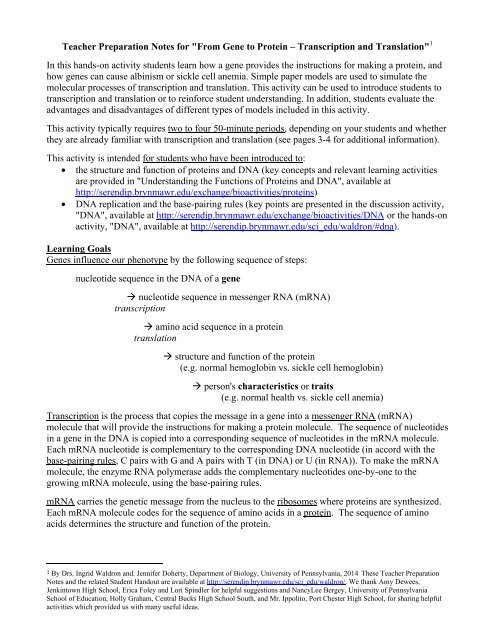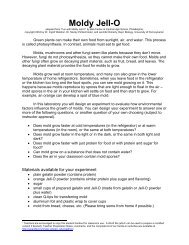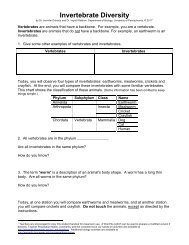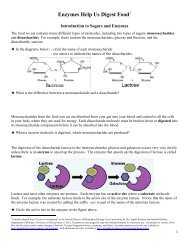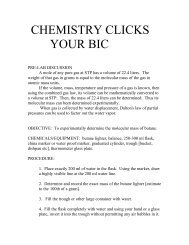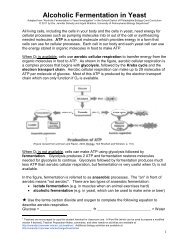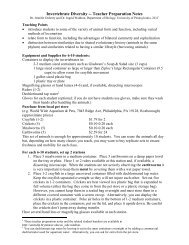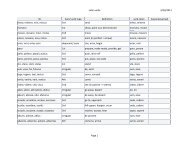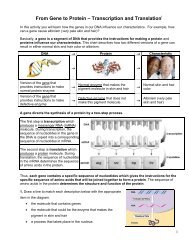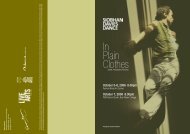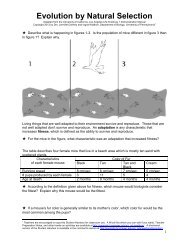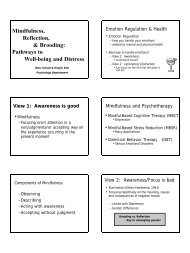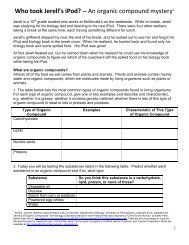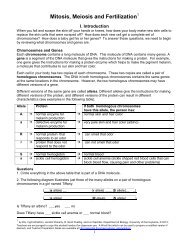From Gene to Protein -- Transcription and Translation ... - Serendip
From Gene to Protein -- Transcription and Translation ... - Serendip
From Gene to Protein -- Transcription and Translation ... - Serendip
Create successful ePaper yourself
Turn your PDF publications into a flip-book with our unique Google optimized e-Paper software.
Teacher Preparation Notes for "<strong>From</strong> <strong>Gene</strong> <strong>to</strong> <strong>Protein</strong> – <strong>Transcription</strong> <strong>and</strong> <strong>Translation</strong>" 1<br />
In this h<strong>and</strong>s-on activity students learn how a gene provides the instructions for making a protein, <strong>and</strong><br />
how genes can cause albinism or sickle cell anemia. Simple paper models are used <strong>to</strong> simulate the<br />
molecular processes of transcription <strong>and</strong> translation. This activity can be used <strong>to</strong> introduce students <strong>to</strong><br />
transcription <strong>and</strong> translation or <strong>to</strong> reinforce student underst<strong>and</strong>ing. In addition, students evaluate the<br />
advantages <strong>and</strong> disadvantages of different types of models included in this activity.<br />
This activity typically requires two <strong>to</strong> four 50-minute periods, depending on your students <strong>and</strong> whether<br />
they are already familiar with transcription <strong>and</strong> translation (see pages 3-4 for additional information).<br />
This activity is intended for students who have been introduced <strong>to</strong>:<br />
• the structure <strong>and</strong> function of proteins <strong>and</strong> DNA (key concepts <strong>and</strong> relevant learning activities<br />
are provided in "Underst<strong>and</strong>ing the Functions of <strong>Protein</strong>s <strong>and</strong> DNA", available at<br />
http://serendip.brynmawr.edu/exchange/bioactivities/proteins)<br />
• DNA replication <strong>and</strong> the base-pairing rules (key points are presented in the discussion activity,<br />
"DNA", available at http://serendip.brynmawr.edu/exchange/bioactivities/DNA or the h<strong>and</strong>s-on<br />
activity, "DNA", available at http://serendip.brynmawr.edu/sci_edu/waldron/#dna).<br />
Learning Goals<br />
<strong>Gene</strong>s influence our phenotype by the following sequence of steps:<br />
nucleotide sequence in the DNA of a gene<br />
nucleotide sequence in messenger RNA (mRNA)<br />
transcription<br />
amino acid sequence in a protein<br />
translation<br />
structure <strong>and</strong> function of the protein<br />
(e.g. normal hemoglobin vs. sickle cell hemoglobin)<br />
person's characteristics or traits<br />
(e.g. normal health vs. sickle cell anemia)<br />
<strong>Transcription</strong> is the process that copies the message in a gene in<strong>to</strong> a messenger RNA (mRNA)<br />
molecule that will provide the instructions for making a protein molecule. The sequence of nucleotides<br />
in a gene in the DNA is copied in<strong>to</strong> a corresponding sequence of nucleotides in the mRNA molecule.<br />
Each mRNA nucleotide is complementary <strong>to</strong> the corresponding DNA nucleotide (in accord with the<br />
base-pairing rules, C pairs with G <strong>and</strong> A pairs with T (in DNA) or U (in RNA)). To make the mRNA<br />
molecule, the enzyme RNA polymerase adds the complementary nucleotides one-by-one <strong>to</strong> the<br />
growing mRNA molecule, using the base-pairing rules.<br />
mRNA carries the genetic message from the nucleus <strong>to</strong> the ribosomes where proteins are synthesized.<br />
Each mRNA molecule codes for the sequence of amino acids in a protein. The sequence of amino<br />
acids determines the structure <strong>and</strong> function of the protein.<br />
1 By Drs. Ingrid Waldron <strong>and</strong>. Jennifer Doherty, Department of Biology, University of Pennsylvania, 2014 . These Teacher Preparation<br />
Notes <strong>and</strong> the related Student H<strong>and</strong>out are available at http://serendip.brynmawr.edu/sci_edu/waldron/. We thank Amy Dewees,<br />
Jenkin<strong>to</strong>wn High School, Erica Foley <strong>and</strong> Lori Spindler for helpful suggestions <strong>and</strong> NancyLee Bergey, University of Pennsylvania<br />
School of Education, Holly Graham, Central Bucks High School South, <strong>and</strong> Mr. Ippoli<strong>to</strong>, Port Chester High School, for sharing helpful<br />
activities which provided us with many useful ideas.
<strong>Translation</strong> is the process that makes proteins. In the process of translation, the sequence of<br />
nucleotides in an mRNA molecule specifies the sequence of amino acids in a protein. Each triplet<br />
codon in the mRNA codes for a specific amino acid in the protein. The ribosome adds amino acids<br />
one-by-one <strong>to</strong> the growing protein in accord with the instructions from the codons in the mRNA<br />
molecule.<br />
tRNA molecules are needed for translation. Different types of tRNA bring the right amino acids for<br />
each position in the protein as it is synthesized by the ribosome. Each type of tRNA has an anti-codon<br />
with three nucleotides which are matched by the base-pairing rules <strong>to</strong> the three nucleotides in an<br />
mRNA codon. For each type of tRNA, there is a specific enzyme that recognizes the anti-codon <strong>and</strong><br />
attaches the correct amino acid <strong>to</strong> the tRNA.<br />
A comparison between transcription <strong>and</strong> DNA replication shows:<br />
Similarities<br />
Differences<br />
- Both transcription <strong>and</strong> replication are carried - A single gene is transcribed in<strong>to</strong> an mRNA<br />
out by a polymerase enzyme which adds molecule, whereas the whole chromosome is<br />
nucleotide monomers one at a time.<br />
replicated.<br />
- Both use the base-pairing rules <strong>to</strong> match each - <strong>Transcription</strong> produces a single-str<strong>and</strong>ed mRNA<br />
new nucleotide in the growing RNA or DNA molecule whereas replication produces a doublestr<strong>and</strong>ed<br />
DNA molecule.<br />
polymer with the nucleotide in the DNA<br />
molecule that provides the instructions for - The enzymes required are RNA polymerase <strong>and</strong><br />
transcription or replication, respectively. DNA polymerase, respectively.<br />
- Thymine in DNA is replaced by uracil in RNA.<br />
Different types of models serve different purposes for learning about <strong>and</strong> underst<strong>and</strong>ing how genes<br />
influence characteristics, including the molecular processes of transcription <strong>and</strong> translation. Like all<br />
models, the models presented in the Student H<strong>and</strong>out involve simplifications which help <strong>to</strong> clarify<br />
important points, but also limit the accuracy of the models as representations of the actual complex<br />
biological processes.<br />
In accord with the Next <strong>Gene</strong>ration Science St<strong>and</strong>ards (http://www.nextgenscience.org/nextgeneration-science-st<strong>and</strong>ards),<br />
students will:<br />
• gain underst<strong>and</strong>ing of Disciplinary Core Ideas LS3.A <strong>and</strong> LS3.B, Inheritance <strong>and</strong> Variation of<br />
Traits, including "<strong>Gene</strong>s chiefly regulate a specific protein, which affect an individual's traits." <strong>and</strong><br />
"DNA carries instructions for forming species characteristics."<br />
• engage in Science Practices, including "Evaluate merits <strong>and</strong> limitations of two different models of<br />
the same… process…" <strong>and</strong> "use multiple types of models <strong>to</strong> provide mechanistic accounts <strong>and</strong>/or<br />
predict phenomena, <strong>and</strong> move flexibly between model types…".<br />
Supplies needed<br />
For each pair of students, use the templates shown beginning on page 9 of these Teacher Preparation<br />
Notes <strong>to</strong> make:<br />
• a page labeled Nucleus <strong>and</strong> a page labeled Ribosome 2 (To encourage accurate modeling, we<br />
recommend that you cut out the 3 mm x 25 mm slots in the nucleus <strong>and</strong> ribosome pages <strong>and</strong> have<br />
your students insert the DNA <strong>and</strong> RNA molecules through these slots so that initially only the<br />
beginning of the DNA or RNA molecule can be seen; for the ribosomes, you may want <strong>to</strong> make the<br />
2 The nucleus <strong>and</strong> ribosome pages can be reused in multiple classes, especially if they are printed on card s<strong>to</strong>ck or heavy<br />
paper. We are interested in the possibility of laminating all items used in this simulation, so that everything could be<br />
reused in multiple classes. We haven't actually tried this, so if you try lamination, please send us feedback about how<br />
well or poorly this worked (iwaldron@sas.upenn.edu). Thank you!<br />
2
slots slightly longer so the part of the mRNA molecule that students produce by taping <strong>to</strong>gether<br />
nucleotides will fit through.)<br />
• the following disposable items 3 :<br />
• DNA molecule on colored paper (cut the page in strips)<br />
• Second Part of mRNA strip <strong>and</strong> 9 RNA nucleotides on a different color paper (each pair of<br />
students will need 1A, 2 C, 3 G, <strong>and</strong> 3 U)<br />
• 6 tRNA molecules on same color paper as RNA nucleotides (cut each tRNA rectangle <strong>to</strong><br />
include the three nucleotides <strong>and</strong> the words "amino acid" directly above these nucleotides; one<br />
of each type of tRNA for each pair of students)<br />
• 6 amino acids on a different color paper (one of each amino acid for each pair of students)<br />
• transparent tape<br />
Depending on your students, you may want <strong>to</strong> prepare a packet with all the supplies for each pair of<br />
students or you may want <strong>to</strong> dole out supplies as needed for each step in the simulation <strong>and</strong> have the 9<br />
RNA nucleotides, the 6 tRNA molecules <strong>and</strong> the 6 amino acids for each student pair in three separate<br />
coin envelopes.<br />
Suggestions for Implementation<br />
We recommend the following sequence:<br />
1. To stimulate student interest <strong>and</strong> get your students thinking about the <strong>to</strong>pic, you may want <strong>to</strong> begin<br />
with the probe question "How can differences in DNA molecules cause differences in a person's<br />
appearance or health" The examples discussed in this activity are the genes for albinism (<strong>to</strong>p half<br />
of page 1 of the Student H<strong>and</strong>out) <strong>and</strong> sickle cell anemia (page 11).<br />
2. Introduce the basic functions <strong>and</strong> processes of transcription <strong>and</strong> translation (using the information<br />
on page 1 of the Student H<strong>and</strong>out). Have students answer questions 1-3, <strong>and</strong> discuss their answers.<br />
3. Explain how transcription occurs (using the material on page 2 of the Student H<strong>and</strong>out, including<br />
questions 4-5). Show the basic version of the animation of transcription of a gene produced by the<br />
Howard Hughes Medical Institute (http://www.hhmi.org/biointeractive/dna-transcription-basicdetail).<br />
This animation provides a dynamic simulation of the basic process of transcription <strong>and</strong> also<br />
illustrates the amazing rapidity of the process; RNA polymerase adds about 50 nucleotides per<br />
second <strong>to</strong> the growing mRNA molecule.<br />
4. Have students model transcription by carefully following the instructions on page 3 of the Student<br />
H<strong>and</strong>out; try <strong>to</strong> make sure that each pair of students carries out each step accurately in order <strong>to</strong><br />
ensure accurate underst<strong>and</strong>ing of the process of transcription.<br />
5. Have students answer questions 7-9 <strong>and</strong> discuss their answers.<br />
6. Explain how translation occurs (pages 4-5 of the Student H<strong>and</strong>out) <strong>and</strong> show the basic version of<br />
the animation of translation (http://www.hhmi.org/biointeractive/translation-basic-detail). (A<br />
ribosome adds about 2-20 amino acids per second, in eukaryotes <strong>and</strong> bacteria, respectively.)<br />
7. Have students model translation by carefully following the instructions on pages 6-8 of the Student<br />
H<strong>and</strong>out.<br />
8. Have students answer questions 16-21 <strong>and</strong> discuss their answers.<br />
9. Discuss how different alleles result in different versions of a protein which in turn can result in<br />
different characteristics (e.g. albinism vs. not) (page 10 of the Student H<strong>and</strong>out). Have students<br />
answer questions 22-26 <strong>and</strong> discuss their answers. During the discussion, we recommend showing<br />
the sickle cell anemia video (http://www.hhmi.org/biointeractive/sickle-cell-anemia).<br />
10. Introduce the concept of a model <strong>and</strong> have students work in pairs <strong>to</strong> answer question 27 <strong>to</strong> evaluate<br />
the advantages <strong>and</strong> disadvantages of the different types of models included in this activity. Discuss<br />
their answers.<br />
3 The DNA molecule, second part of mRNA strip, <strong>and</strong> tRNA molecules may be reusable in multiple classes, especially if<br />
they are printed on card s<strong>to</strong>ck or heavy paper.<br />
3
If you plan <strong>to</strong> use this activity <strong>to</strong> introduce transcription <strong>and</strong> translation, this sequence will probably<br />
require four 50-minute periods. Alternatively, if your students already have a basic underst<strong>and</strong>ing of<br />
transcription <strong>and</strong> translation, you may be able <strong>to</strong> complete this activity in two 50-minute periods.<br />
We recommend that you have your students work in pairs <strong>to</strong> model transcription <strong>and</strong> translation <strong>and</strong><br />
also <strong>to</strong> answer the questions.<br />
To use this modeling activity <strong>to</strong> facilitate student underst<strong>and</strong>ing of how transcription takes place, it is<br />
important for them <strong>to</strong> add each nucleotide one at a time, mimicking the actual activity of RNA<br />
polymerase. Some students will want <strong>to</strong> lay out all the mRNA nucleotides <strong>and</strong> tape them <strong>to</strong>gether all<br />
at once, which is more efficient in getting the task done, but less effective in modeling <strong>and</strong><br />
underst<strong>and</strong>ing the real biological process. Similarly, during translation, the students should mimic the<br />
actual function of the ribosome by bringing in one tRNA with amino acid at a time. Using the slots in<br />
the nucleus <strong>and</strong> ribosome pages helps <strong>to</strong> encourage students <strong>to</strong> do the modeling correctly.<br />
To help your students underst<strong>and</strong> why RNA polymerase adds nucleotides one at a time <strong>and</strong> ribosomes<br />
add amino acids one at a time, you may want <strong>to</strong> point out that a typical protein has hundreds of amino<br />
acids. Have your students think about the problems that would arise if natural selection or a molecular<br />
biologist tried <strong>to</strong> design a ribosome that could simultaneously arrange <strong>and</strong> bond <strong>to</strong>gether the whole<br />
sequence of amino acids in a protein, especially considering that there are many thous<strong>and</strong>s of different<br />
types of proteins in a cell. Similarly, have your students think about the problems of trying <strong>to</strong> design an<br />
enzyme that could simultaneously arrange <strong>and</strong> join <strong>to</strong>gether the whole sequence of nucleotides in an<br />
mRNA molecule.<br />
We find that, at each step, you have <strong>to</strong> be very explicit in your instructions in order <strong>to</strong> prevent students<br />
from racing ahead in ways that undermine the learning goals. For example, in the transcription<br />
activity students should not tape the RNA nucleotides <strong>to</strong> the DNA nucleotides, since these are not<br />
linked by covalent bonds. (You might want <strong>to</strong> provide masking tape or low stick painters' tape <strong>to</strong><br />
represent the weaker hydrogen bonds between complementary nucleotides.)<br />
For the simulation, it is important <strong>to</strong> make sure that one student in each pair is acting as the cy<strong>to</strong>plasm<br />
<strong>and</strong> the other student is acting as the RNA polymerase or ribosome. If appropriate, you may want <strong>to</strong><br />
require your students <strong>to</strong> check off each arrow indicating a step in the simulation <strong>and</strong> also answer any<br />
questions before moving on <strong>to</strong> the next step. To demonstrate the proper procedures, you may want <strong>to</strong><br />
project images of the nucleus, ribosome, <strong>and</strong> relevant molecules.<br />
To encourage students <strong>to</strong> actively synthesize their own basic underst<strong>and</strong>ing of transcription <strong>and</strong><br />
translation, we strongly recommend assigning question 9 on page 4 <strong>and</strong> question 21 on page 9 of the<br />
Student H<strong>and</strong>out, perhaps as a homework assignment if you do not have time during the class periods.<br />
If you feel that these questions will be challenging for your students, we have several suggestions <strong>to</strong><br />
help your students meet this challenge.<br />
• Immediately before the students answer question 9, you may want <strong>to</strong> show the video at<br />
http://www.hhmi.org/biointeractive/dna-transcription-basic-detail <strong>to</strong> refresh students' memory of<br />
the overall process of transcription. Similarly, immediately before students answer question 21,<br />
you can show the video at http://www.hhmi.org/biointeractive/translation-basic-detail.<br />
• You could provide a first sentence <strong>and</strong> the beginning of a second sentence <strong>to</strong> help your students get<br />
started.<br />
• You may want <strong>to</strong> rearrange the word list from its current alphabetical order in<strong>to</strong> a suggestive<br />
sequence or clusters of related concepts.<br />
• If your students have particular difficulty learning vocabulary, you may want <strong>to</strong> precede questions<br />
9 <strong>and</strong> 21 with questions that ask for definitions of the terms listed (or perhaps a matching question<br />
4
in which you provide your preferred definitions for these terms).<br />
To ensure that students develop a good underst<strong>and</strong>ing of the basic processes of transcription <strong>and</strong><br />
translation, this activity omits many complexities (e.g. proteins may have more than one polypeptide;<br />
introns, exons <strong>and</strong> splicing). If your students already have a good grasp of the basic processes, you<br />
may want <strong>to</strong> include some of these points. For example, if you want <strong>to</strong> emphasize learning how <strong>to</strong> use<br />
the st<strong>and</strong>ard chart of codons in mRNA <strong>and</strong> corresponding amino acids, you can replace the chart on the<br />
<strong>to</strong>p of page 5 of the Student H<strong>and</strong>out with the codon chart from your textbook or from the activity<br />
described at the end of this paragraph. This would also provide the opportunity <strong>to</strong> discuss the function<br />
of the start <strong>and</strong> s<strong>to</strong>p codons in initiating <strong>and</strong> terminating translation. Our preference is <strong>to</strong> use the<br />
simplified chart on page 5 of the Student H<strong>and</strong>out, so students can concentrate on underst<strong>and</strong>ing the<br />
process of translation, <strong>and</strong> then later practice using the st<strong>and</strong>ard codon chart in a separate activity such<br />
as "<strong>From</strong> <strong>Gene</strong> <strong>to</strong> Polypeptide – The Roles of the Base-Pairing Rules <strong>and</strong> the <strong>Gene</strong>tic Code"<br />
(http://serendip.brynmawr.edu/exchange/bioactivities/basepair); this discussion/worksheet activity<br />
reviews the information flow from a gene <strong>to</strong> a polypeptide, with an emphasis on underst<strong>and</strong>ing the<br />
roles of the base-pairing rules <strong>and</strong> the genetic code chart.<br />
Background Biology <strong>and</strong> Suggestions for Discussion<br />
The basic points <strong>and</strong> information <strong>to</strong> be included in discussing the questions in the Student H<strong>and</strong>out are<br />
provided in the answer key, available upon request <strong>to</strong> iwaldron@sas.upenn.edu. Additional relevant<br />
background information is provided in the following sections, primarily <strong>to</strong> give you information that<br />
may be helpful for responding <strong>to</strong> student questions.<br />
The type of albinism discussed in the introduction <strong>to</strong> this activity is called oculocutaneous albinism,<br />
because the melanin deficiency results in vision problems as well as pale skin <strong>and</strong> hair color. This type<br />
of albinism is due <strong>to</strong> a defect in the tyrosinase enzyme which catalyzes the first step in the production<br />
of melanin (http://ghr.nlm.nih.gov/gene/TYR).<br />
<strong>Transcription</strong> <strong>and</strong> <strong>Translation</strong><br />
If your students are somewhat hazy about nucleic acid structure <strong>and</strong> the base-pairing rules you may<br />
want <strong>to</strong> use the figure shown on the next page <strong>to</strong> remind them of key background information for<br />
underst<strong>and</strong>ing the discussion of the base-pairing rules on page 2 of the Student H<strong>and</strong>out.<br />
The DNA str<strong>and</strong> we provide is the template str<strong>and</strong> (i.e. the DNA str<strong>and</strong> that is transcribed) for the beta<br />
globin polypeptide of the hemoglobin protein. The other str<strong>and</strong> of the DNA double helix is called the<br />
non-template or sense str<strong>and</strong>; it has the same nucleotide sequence as the RNA produced by<br />
transcription (except of course T in DNA is replaced by U in RNA). If your students ask how the<br />
RNA polymerase is directed <strong>to</strong> transcribe the right str<strong>and</strong> of the DNA double helix, you can explain the<br />
role of the promoter in initiating transcription. This would also provide the opportunity <strong>to</strong> mention that<br />
the rate of transcription of specific genes varies in different types of cells, corresponding <strong>to</strong> the<br />
differences in specific types of proteins in different types of cells (e.g. hemoglobin abundant in red<br />
blood cells <strong>and</strong> the enzyme for making melanin abundant in melanocytes in the skin).<br />
5
(from Krogh, Biology: a Guide <strong>to</strong> the Natural World)<br />
The bonds within each str<strong>and</strong> are covalent bonds. In contrast, base pairing involves weaker hydrogen<br />
bonds which are more readily broken as occurs during transcription <strong>and</strong> translation. During<br />
transcription, multiple different nucleotides enter <strong>and</strong> leave the RNA polymerase, but, for each DNA<br />
nucleotide only the complementary RNA nucleotide that has the right shape <strong>and</strong> charges <strong>to</strong> form<br />
multiple hydrogen bonds with that specific DNA nucleotide will remain in place <strong>to</strong> be covalently<br />
bonded <strong>to</strong> the preceding RNA nucleotide.<br />
The enzyme that binds each tRNA <strong>to</strong> the appropriate amino acid forms a covalent bond between the<br />
tRNA <strong>and</strong> amino acid. 4 Inside the ribosome there is a ribozyme (RNA enzyme) that simultaneously<br />
breaks this covalent bond <strong>and</strong> forms a new covalent peptide bond between this amino acid <strong>and</strong> the<br />
previous amino acid in the growing polypeptide chain; thus, this ribozyme, transfers the amino acid<br />
from the tRNA <strong>to</strong> the growing polypeptide chain. Ribosomes have three sites for tRNAs, including the<br />
sites we have shown in our model ribosome <strong>and</strong> a third site (<strong>to</strong> the left) where the tRNA that has lost<br />
its amino acid is located before it exits the ribosome.<br />
There are 40-45 different types of tRNA, with some types of tRNA able <strong>to</strong> match with two different<br />
codons that have the same first two nucleotides but differ in the third nucleotide (both are codons for<br />
the same amino acid). Some students have difficulty underst<strong>and</strong>ing the function of the tRNA<br />
molecule. An analogy that may help them underst<strong>and</strong> is as follows. Suppose a group of American<br />
4 A simulation of this enzyme in action is available at<br />
http://www.phschool.com/science/biology_place/biocoach/translation/addaa.html<br />
6
<strong>to</strong>urists goes in<strong>to</strong> a restaurant in China <strong>and</strong> each one wants <strong>to</strong> order his or her favorite Chinese dish.<br />
Suppose the <strong>to</strong>urists only speak English, <strong>and</strong> the cook only speaks Chinese. It will be very helpful <strong>to</strong><br />
have a waiter who underst<strong>and</strong>s English <strong>and</strong> can speak Chinese, so he can serve as a transla<strong>to</strong>r. The<br />
<strong>to</strong>urists are equivalent <strong>to</strong> the mRNA which specifies which amino acids should be incorporated in<br />
which position in the growing protein molecule, <strong>and</strong> the cook is equivalent <strong>to</strong> the cy<strong>to</strong>plasm which<br />
provides the different types of amino acids. The waiter is equivalent <strong>to</strong> the tRNA molecules which<br />
bring the right amino acids <strong>to</strong> the right locations.<br />
Sickle Cell Hemoglobin <strong>and</strong> Sickle Cell Anemia<br />
This section of the activity discusses transcription <strong>and</strong> translation of the beginning of the gene for the<br />
beta globin polypeptides in the hemoglobin tetramer protein <strong>and</strong> ignores the gene for the alpha globin<br />
polypeptides. The alpha globin gene <strong>and</strong> polypeptides are the same in normal <strong>and</strong> sickle cell<br />
hemoglobin. You may want <strong>to</strong> explain that the lower solubility of nonpolar valine in the watery<br />
cy<strong>to</strong>sol of the red blood cell (compared <strong>to</strong> the high solubility of ionic glutamic acid) contributes <strong>to</strong> the<br />
tendency of sickle cell hemoglobin <strong>to</strong> clump <strong>to</strong>gether in long rods inside the red blood cells. This<br />
difference in the solubility of amino acid 6 is crucial because amino acid 6 is on the outside of the<br />
hemoglobin molecule.<br />
This section of the activity summarizes the effects of homozygous sickle cell alleles, resulting in sickle<br />
cell anemia. Even in a person who has severe sickle cell anemia, most red blood cells are not sickled<br />
most of the time. Variation in the degree of clumping of sickle cell hemoglobin in<strong>to</strong> rods, sickling of<br />
red blood cells, <strong>and</strong> consequent symp<strong>to</strong>ms is influenced by multiple fac<strong>to</strong>rs, including oxygen levels in<br />
the blood, dehydration, <strong>and</strong> multiple genetic fac<strong>to</strong>rs.<br />
Sickling crises that block the blood flow in some of the small blood vessels result in pain <strong>and</strong> organ<br />
damage. The causes of these crises are often unknown, but some sickling crises are triggered by an<br />
infection that induces vomiting <strong>and</strong> diarrhea which can result in dehydration; dehydration increases the<br />
concentration of hemoglobin in red blood cells <strong>and</strong> thus increases the tendency of sickle cell<br />
hemoglobin <strong>to</strong> clump in<strong>to</strong> long rods, resulting in the sickling <strong>and</strong> other irregular shapes of red blood<br />
cells that cause blockage of the small blood vessels.<br />
7
The severity of sickle cell anemia in different individuals varies from relatively mild sickle cell anemia<br />
with few sickling crises <strong>and</strong> nearly normal health <strong>and</strong> survival <strong>to</strong> severe sickle cell anemia with<br />
frequent sickling crises, significant organ damage <strong>and</strong> early death. The majority of people with sickle<br />
cell anemia have an intermediate severity. One fac<strong>to</strong>r that contributes <strong>to</strong> variation in the frequency of<br />
sickling crises is that some people with sickle cell anemia spontaneously produce relatively high levels<br />
of fetal hemoglobin (which contains gamma globin instead of beta globin peptides), <strong>and</strong> fetal<br />
hemoglobin inhibits clumping of sickle cell hemoglobin. Hydroxyurea, which increases the production<br />
of fetal hemoglobin, is one treatment for sickle cell anemia. A good summary of the medical aspects<br />
of sickle cell anemia, including symp<strong>to</strong>ms, diagnosis <strong>and</strong> treatment is available at<br />
http://www.mayoclinic.com/health/sickle-cell-anemia/DS00324.<br />
An individual who is heterozygous for the sickle cell allele (sickle cell trait) almost always has no<br />
symp<strong>to</strong>ms because each red blood cell contains both normal <strong>and</strong> sickle cell hemoglobin <strong>and</strong> the normal<br />
hemoglobin generally prevents clumping of the sickle cell hemoglobin. Athletic associations<br />
recommend testing for sickle cell trait <strong>and</strong>, for athletes with sickle cell trait, taking appropriate<br />
precautions <strong>to</strong> prevent extreme exertion <strong>and</strong> dehydration in order <strong>to</strong> reduce the small but significant<br />
risk of exercise-related sudden death. Harmful health effects of sickle cell trait are rare, <strong>and</strong> life<br />
expectancy is not detectable reduced. Individuals with sickle cell trait have less serious malaria<br />
infections because the malaria parasite doesn't grow as well in their red blood cells.<br />
In discussing question 26, you may want <strong>to</strong> point out that our bodies are made up of roughly 100,000<br />
different types of proteins <strong>and</strong> each protein is made up of hundreds or thous<strong>and</strong>s of amino acids, so<br />
there is a great deal of opportunity for variation in genes, proteins <strong>and</strong> characteristics. In addition, there<br />
are inherited differences in the regulation of the amount of expression of various genes, <strong>and</strong> this is<br />
another important source of variation in human characteristics.<br />
Evaluating Models<br />
Thinking about <strong>and</strong> discussing their answers <strong>to</strong> question 27 will help students <strong>to</strong> underst<strong>and</strong> that<br />
different types of models can serve different purposes. Discussion of question 27 also provides the<br />
opportunity <strong>to</strong> illustrate how models help us <strong>to</strong> underst<strong>and</strong> complex phenomena by focusing on basic<br />
features of the phenomena <strong>and</strong> ignoring other complexities; however, the simplifications incorporated<br />
in models can also limit the accuracy of our underst<strong>and</strong>ing of complex biological phenomena.<br />
Answering this question should also help <strong>to</strong> reinforce basic biological principles students have learned<br />
in this activity.<br />
The key does not include suggestions for how <strong>to</strong> improve the models, because we have already<br />
incorporated all the suggestions we could think of. Obviously, we anticipate that many or most<br />
students will not have suggestions for improvements in these models, but if you or your students do<br />
develop suggestions for improvements, please send them <strong>to</strong> iwaldron@sas.upenn.edu. Thank you!<br />
Related Activities<br />
"Molecular Biology: Major Concepts <strong>and</strong> Learning Activities" (available at<br />
http://serendip.brynmawr.edu/exchange/bioactivities/MolBio) is an overview that reviews key<br />
concepts <strong>and</strong> learning activities. Topics covered include basic underst<strong>and</strong>ing of the important roles of<br />
proteins <strong>and</strong> DNA, DNA structure <strong>and</strong> replication, <strong>and</strong> the molecular biology of how genes influence<br />
traits, including transcription, translation, <strong>and</strong> the molecular biology of mutations. To help students<br />
underst<strong>and</strong> the relevance of these molecular processes, the suggested learning activities link alleles of<br />
specific genes <strong>to</strong> human characteristics such as albinism, sickle cell anemia <strong>and</strong> muscular dystrophy.<br />
Several potential follow-up activities are suggested, including "The Molecular Biology of Mutations<br />
<strong>and</strong> Muscular Dystrophy" (available at http://serendip.brynmawr.edu/exchange/bioactivities/mutation).<br />
8
Nucleus<br />
RNA polymerase<br />
place where enzyme forms<br />
covalent bond between nucleotides<br />
RNA nucleotide<br />
next RNA<br />
nucleotide<br />
slot<br />
DNA<br />
cy<strong>to</strong>plasm<br />
around the nucleus
Ribosome<br />
place where ribosome forms<br />
covalent bond between amino acids<br />
tRNA with<br />
amino acid<br />
tRNA with next<br />
amino acid<br />
slot<br />
codon<br />
next codon<br />
mRNA
Beginning of<br />
Hemoglobin<br />
<strong>Gene</strong><br />
Beginning of<br />
Hemoglobin<br />
<strong>Gene</strong><br />
Beginning of<br />
Hemoglobin<br />
<strong>Gene</strong><br />
Beginning of<br />
Hemoglobin<br />
<strong>Gene</strong><br />
Beginning of<br />
Hemoglobin<br />
<strong>Gene</strong><br />
Beginning of<br />
Hemoglobin<br />
<strong>Gene</strong><br />
Beginning of<br />
Hemoglobin<br />
<strong>Gene</strong><br />
Beginning of<br />
Hemoglobin<br />
<strong>Gene</strong><br />
Beginning of hemoglobin gene - 8 sets<br />
C A C G T A G A C<br />
C A C G T A G A C<br />
C A C G T A G A C<br />
C A C G T A G A C<br />
C A C G T A G A C<br />
C A C G T A G A C<br />
C A C G T A G A C<br />
C A C G T A G A C
Second Part of mRNA - 8 sets<br />
A<br />
C U C C U G A G<br />
Second Part<br />
of mRNA<br />
A<br />
A<br />
A<br />
A<br />
A<br />
A<br />
A<br />
C U C C U G A G<br />
Second Part<br />
of mRNA<br />
C U C C U G A G<br />
Second Part<br />
of mRNA<br />
C U C C U G A G<br />
Second Part<br />
of mRNA<br />
C U C C U G A G<br />
Second Part<br />
of mRNA<br />
C U C C U G A G<br />
Second Part<br />
of mRNA<br />
C U C C U G A G<br />
Second Part<br />
of mRNA<br />
C U C C U G A G<br />
Second Part<br />
of mRNA
RNA neuclotides - 8 sets<br />
A C C G G G U U U<br />
A C C G G G U U U<br />
A C C G G G U U U<br />
A C C G G G U U U<br />
A C C G G G U U U<br />
A C C G G G U U U<br />
A C C G G G U U U<br />
A C C G G G U U U
tRNA molecules - 2 sets<br />
Amino Acid<br />
G A C<br />
Amino Acid<br />
Amino Acid<br />
G G A<br />
G G A<br />
Amino Acid<br />
Amino Acid<br />
C U C<br />
Amino Acid<br />
G U A<br />
Amino Acid<br />
U<br />
Amino Acid<br />
C U C<br />
Amino Acid<br />
C A C<br />
Amino Acid<br />
U<br />
G A<br />
Amino Acid<br />
C A C<br />
Amino Acid<br />
G A C<br />
G U A<br />
G A
amino acids - 4 sets<br />
Leucine Histidine Valine<br />
Leucine Histidine Valine<br />
Leucine Histidine Valine<br />
Leucine Histidine Valine<br />
Threonine<br />
Threonine<br />
Threonine<br />
Threonine<br />
Proline<br />
Proline<br />
Proline<br />
Proline<br />
Glutamic Acid<br />
Glutamic Acid<br />
Glutamic Acid<br />
Glutamic Acid


